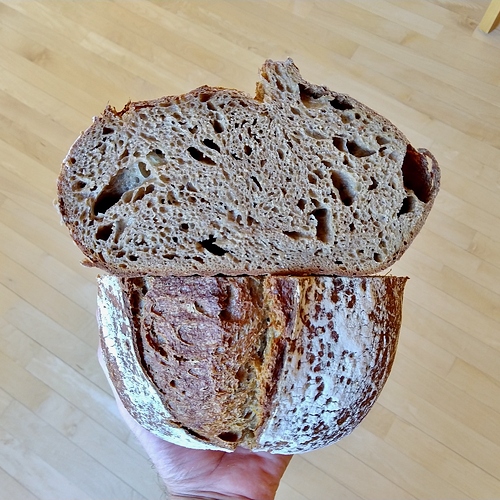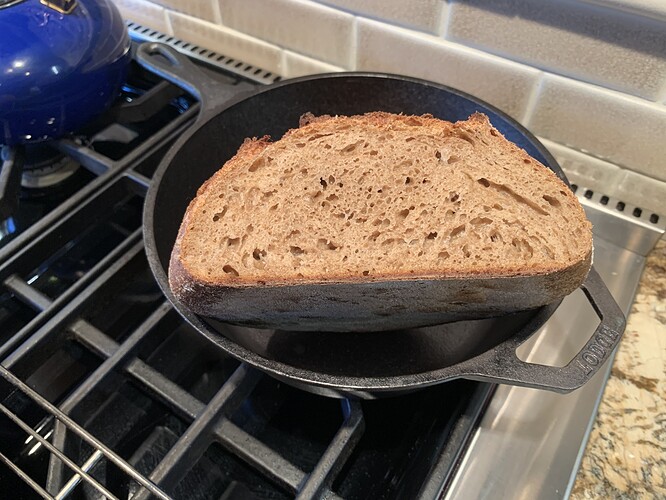You are absolutely right. I did misread.  So the bulk fermentation is the same in both the general text AND the recipe: room temperature. All good. It’s the length of time that is what I found so appealing. Wow. Thanks for your patience. Hope I didn’t cause a lot of eye-rolling.
So the bulk fermentation is the same in both the general text AND the recipe: room temperature. All good. It’s the length of time that is what I found so appealing. Wow. Thanks for your patience. Hope I didn’t cause a lot of eye-rolling.
Not at all. Glad to help. I’ve done recipes similar to this, a variation on a theme, and they are delicious. Get ready to rethink bread making. Bread is what happens while you wait! 
No toe-stepping involved. Thanks @anon44372566 for minding the store while I was working outside. I have nothing to add and you have understood the loose method I described perfectly. Mix Thursday evening and leave it overnight. A couple stretch and folds early Friday morning and then wait till the dough about doubles, then shape and into the fridge until Saturday morning.
My loaf is 100% whole grain, but I am sure that you could do exactly the same thing with some percentage of white bread flour as well. Depending on your percentage of white flour, you’d probably want to decrease the hydration some to maintain the same dough consistency.
Indeed, time is a significant ingredient in the “recipe”.
Nice recipe Paul. I’m on a bit of a gluten free sourdough roll for the time being. But when I return to regular sourdough I’ve got this one bookmarked. Glad I did it justice 
Hey Jeff, thanks for linking your blog post - it was nice to read and I loved the conversational tone!
I was wondering if I may poke you for some info: I have a starter thats about 2.5 years now; at the beginning it was AFP, then I converted it to bread flour, then about 1 year ago, to rye (following instructions on the net). Recently - this summer - I can not for the life of me get a good rise of out my loaves. My general feeding schedule is as always, whenever I take from it, I add a 1:1 ratio of water:rye and throw it right back in the fridge. I’ll do this very randomly - sometimes not for 2 or 3 weeks.
For baking, I’ll take off a piece of it, then feed it overnight as a levain, as I’ve done many times - but the next AM there’s maybe a 20-25% rise, nothing else. Am I missing something or making a mistake? One part of me thinks, let me feed it every 4 days. But then I read posts like yours, and also thinking about the various treasure of knowledge out there, and people say (especially with rye) that they feed it only once a month. I’d love to know more about your thoughts if you have any to share!
Hmmm. One thought is that in the summer, it may rise so fast because of the higher temperature that it’s already fallen by the time you wake up? But you say you’re making a levain, so it’s only a portion of your ultimate dough.
Even if it’s fallen, though, there should be enough activity to feed the full dough amount.
Another thought…when you make the full dough amount, are you using the amount of the rise as the trigger for when you put it in the oven? That was a big wakeup call for me. I wait until it doubles (doubles-ish) in size…it’s visibly expanded, and then shape it into a loaf. There were times I just didn’t wait long enough.
Are you using a different kind of flour than you normally do? That could effect the speed of rising, too.
Others on this forum have done way more experimentation than I…so I’d be curious to here other thoughts.
Jeff
So the thing is that I always follow the hour rule - I typically don’t wait until I’ve seen it double. Could that be the issue, I wonder.
Not sure what the “one hour rule” is, but I know that in my first year or so of baking, I relied on time a lot, and discovered later that I was way under-proofing my loaves. I figured that out once when I wasn’t home (or perhaps it was just warmer), and saw how much larger/puffier the dough was from what I was accustomed to. Now, I don’t worry about the time, I just look for that look of a nice puffy dough, that’s likely “doubled in size”. I don’t really now if it’s doubled because I use a stainless steel bowl rather than a clear plastic tub that can be marked. But still, it’s noticeably risen.
I’ve also skipped the whole levain step, and just put my teaspoon to tablespoon of starter in with the water, salt, and flour at the beginning. Its fermenting a long time, so I don’t see the value of the levain. One more step that’s not needed.
My usual workflow is to build the dough in the morning or afternoon the day before I want a finished loaf, and let it ferment until dinner time, or bedtime, depending on when I start, after which I put it in the fridge overnight. During that day, I do a few stretch and folds at no particular time…generally when I wander into the kitchen. The next morning, I pull it out, one more stretch and fold sequence, and let is ferment/rise until it’s ready. In the summer, that could by by lunch time. In the winter, after dinner. My method demands some flexibility, but I generally have a decent sense of how long things take. If the dough is ready before I am, I can always throw it back in the fridge.
Blog post still in serious need of updating…hope to do so soon. Good luck!
LOL, I think @improbablepantry must be my long lost slow lazy twin. I would have written almost exactly the same thing, starting with absolutely EXACTLY the first same few words which is what I thought when I read @floursogoody’s post.
Thank you both for your insights. I didn’t mean a “one hour” I meant that I follow instructions (eg Tartine’s 3 hours or Forkish’s 5 hours). I should probably trust my gut much more and just let it ride!
I’m starting to feel like one of those grandpa’s who keeps telling you the same story over and over, but here’s a link to a post I wrote about ignoring the word “recipe” in sourdough baking.
In my experience, there are especially two things in any sourdough “recipe” that you really have to treat as a starting point for your own modification and not as a hard and fast rule:
- the proofing time
- the amount of water (hydration percentage)
The right amount of both of those things are going to vary so much depending on your temperature and the specific flour that you are baking with, that if you happen to get a good result by following specific directions, it was just luck.
Looks fantastic! You must be thrilled to have your oven up and running. Is this a 60:40 turkey red: hard white blend?
@Fermentada You’re right! The oven! I had forgotten.
@homebreadbaker Melissa’s right, Paul. It must feel great to have your oven working once again. I remember being SO thankful when mine was up and running after blowing that element.
Leah
@Leah1 Mrs. Homebreadbaker and I have been doing everything humanly possible to break the oven again since it’s been fixed. Baking every day.
@Fermentada: it’s 200g of hard white and 400g of red fife. I’m playing around with more gentle dough handling and pushing the hydration a little higher. Seems like it’s opening up the crumb a bit.
How high are you going on the hydration?
That latest loaf the hydration was about 82% (I’ve been making them in the upper 70’s).
Gotcha. I usually go wetter and my flatter bread/minimal ear shows it  Though actually the whole grain breads in the Challenging Sourdough Starter Convention blog post were 82% and basically earless. Sigh.
Though actually the whole grain breads in the Challenging Sourdough Starter Convention blog post were 82% and basically earless. Sigh.
I love this idea! I’ve been thinking about something along the same lines. I’ve been wanting a recipe – or a ‘framework’ - where I can use all fresh milled flour, most use only a fraction. Since fresh milled flour ferments faster and most recipes use more starter, they require shorter bulk fermentation. The shorter bulk fermentation requires more kneading to build strength, resulting in a more labor intensive and time sensitive procedure. I’ve used this schedule several times slightly changing the flours used each time. Most recently I made 2 loaves with:
370 G Fresh Milled Hard Red Spring Wheat
370 G Fresh Milled Sprouted Red Fife Wheat
60 G Fresh Milled Rye
200 G Hard White Whole Wheat Flour
200 G Spelt Flour
960 G Water
24 G Salt
Bulk fermentation lasted 14 hours with no kneading, and the bread was proofed for 18 hours in the refrigerator. It may not have the most open crumb or be perfectly baked and was perhaps over gouged on the scoring, but their not too ugly and taste terrific!
Those look excellent to me. Very nice loft and whole grain crumb.
I don’t know why anyone would want the crumb more open than that. As long as you have a nice spring so your bread isn’t flat and dense, bigger holes just means you can’t put anything on the bread without it falling through onto your plate.


